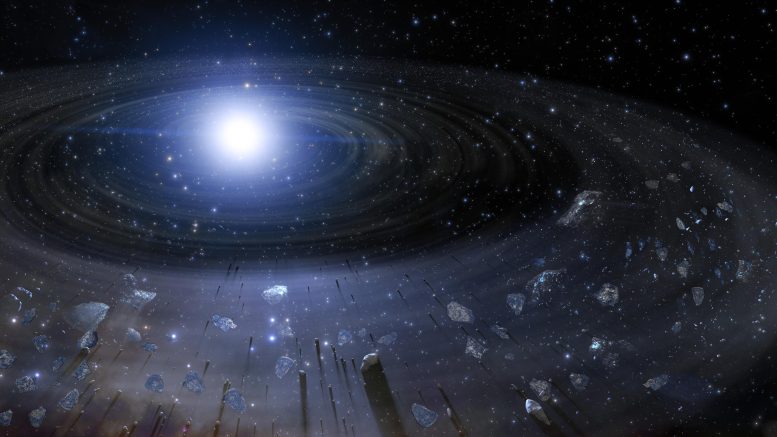Rocky Exoplanets Are Even Stranger Than We Thought

Rocky debris, the pieces of a former rocky planet that has broken up, spiral inward toward a white dwarf in this illustration. Studying the atmospheres of white dwarfs that have been “polluted” by such debris, a NOIRLab astronomer and a geologist have identified exotic rock types that do not exist in our Solar System. The results suggest that nearby rocky exoplanets must be even stranger and more diverse than previously thought. Credit: NOIRLab/NSF/AURA/J. da Silva, Image processing: M. Zamani and M. Kosari (NSF’s NOIRLab)
A new astrogeology study suggests that most nearby rocky exoplanets are quite unlike anything in our Solar System.
An astronomer from NSF’s NOIRLab has teamed up with a geologist from California State University, Fresno, to make the first estimates of rock types that exist on planets orbiting nearby stars. After studying the chemical composition of “polluted” white dwarfs, they have concluded that most rocky planets orbiting nearby stars are more diverse and exotic than previously thought, with types of rocks not found anywhere in our Solar System.
Astronomers have discovered thousands of planets orbiting stars in our galaxy — known as exoplanets. However, it’s difficult to know what exactly these planets are made of, or whether any resemble Earth. To try to find out, astronomer Siyi Xu of NSF’s NOIRLab partnered with geologist Keith Putirka of California State University, Fresno, to study the atmospheres of what are known as polluted white dwarfs. These are the dense, collapsed cores of once-normal stars like the Sun that contain foreign material from planets, asteroids, or other rocky bodies that once orbited the star but eventually fell into the
According to new research by a NOIRLab astronomer and a geologist, rocky exoplanets are even stranger than previously thought. By studying the atmospheres of stellar remnants called white dwarfs, the pair has discovered types of rocks not found in our Solar System. Each white dwarf is “polluted” with material from rocky bodies that originally orbited it but fell into the white dwarf and spread their elements through its atmosphere. Some of the rock compositions are so rare, the scientists had to create new names to classify the types of rocks that once made up these ancient planets.
Putirka and Xu looked at 23 polluted white dwarfs, all within about 650 light-years of the Sun, where calcium, silicon, magnesium, and iron had been measured with precision using the W. M. Keck Observatory in Hawai‘i, the Hubble Space Telescope, and other observatories. The scientists then used the measured…
Read More: Rocky Exoplanets Are Even Stranger Than We Thought
